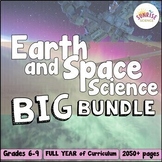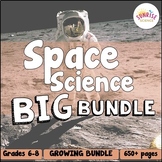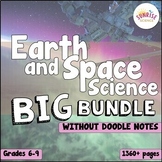Universe Stars Unit light-years constellations gravity electromagnetic spectrum
- PDF
- Google Apps™
- Internet Activities

What educators are saying
Also included in
- This is a bundle of all of my resources for teaching Earth and Space Science at the middle school level! These resources include a mix of Cornell Doodle Notes, lab activities, inquiry activities, digital lessons and units, projects, and pixel art digital content review activities.✨ Please note thatPrice $327.00Original Price $450.24Save $123.24
- This is a bundle of all of my resources for teaching Space Science at the middle school level! These resources include a mix of Cornell Doodle Notes, lab activities, inquiry activities, digital units with assessments, projects, and pixel art digital content review activities.Receive 25% off this BIGPrice $97.00Original Price $129.34Save $32.34
- This is a bundle of all of my resources for teaching Earth and Space Science at the middle school level, EXCLUDING the Cornell Doodle Notes. The resources in this bundle include a mix of digital lessons and units, lab activities, inquiry activities, projects, review activities, and assessments.✨ ThiPrice $259.00Original Price $369.00Save $110.00
Description
This 3+ week blended learning unit on the Universe and its Stars is a series of lessons help students understand the vastness of the universe, the contributions of NASA to space exploration, how light-years are used as a measure of distance in space, star types, constellations, the role of gravity in galaxies, solar systems, and planetary systems, the physics of orbiting, habitable zones of stars, exoplanets, the types of galaxies and the Milky Way, the life cycles of stars and black holes, the electromagnetic spectrum and how space telescopes help us to study the universe.
What is a blended learning unit? Blended learning combines online educational materials and opportunities with physical place-based classroom methods. This resource is the digital 'backbone' component of the unit that is editable and flexible for incorporating hands-on activities and labs and for varying the delivery of lessons to accommodate whole-class discussion, or small group, partner, or individual work.
But PLEASE NOTE! This is NOT a "webquest"! These lessons are written to be a sequential journey through the content and the teacher will still be facilitating the lessons. Students are not left to complete these lessons on their own. The teacher can use best practice pedagogy to have students interacting in whole-class discussions and small group work throughout the unit!
This download includes a Unit Overview Google Doc that is for the Teacher. This document has all of the lessons written out in sections (Lesson 1, Lesson 2, Lesson 3, etc.) so that you can see everything in one place. This document notes how many days (40-45 minute periods) each individual lesson will usually take to complete and it contains most of the answers for the activities. This will help you with planning. It also contains the answers and example student models, links to online review games (Blooket and GimKit), and other study/review resources.
The download also includes 12 separate Google Doc lessons that you will share with your students on Google Classroom. Each of these lessons takes 1 to 2 days to complete. Students will type directly on their copies of these Docs and these are what you will grade for each student.
My students have responded so well to this lesson format because they know what to expect. I love that I can schedule out all of the lessons in Google Classroom and I know what I’m teaching weeks out! The prep is easy and the grading is so easy too.
Please view the PREVIEW for more visuals of how this unit is organized.
This unit was designed to satisfy the following NGSS Standard: MS-ESS1-2: Develop and use a model to describe the role of gravity in the motions within galaxies and the solar system.
This is a list of the topics/concepts covered in each lesson:
Lesson 1: What is the Universe?
Lesson 2: NASA
Lesson 3: Light Years
Lesson 4: Constellations
Lesson 5: Gravity
Lesson 6: Orbiting
Lesson 7: Exoplanets
Lesson 8: Galaxies
Lesson 9: Black Holes
Lesson 10:Stars and the Electromagnetic Spectrum
Lesson 11: Space Telescopes
Lesson 12: The Hubble and James Webb Space Telescopes
Throughout this unit, students will engage in:
- modeling activities and feedback galleries
- digital manipulatives and graphic organizers
- virtual interactives and simulations
- predicting
- observing and explaining phenomena
- video clips
- readings
- formative assessments
- post assessment
- and more!
This unit took me months to plan and it has been completed by my students! They loved it and I had so much fun teaching it! I'm confident that this unit will save you TONS of planning time! You will have 3 weeks of editable and flexible curriculum.
Heads up! You can also get 25% off as part of the Earth & Space Science BIG Bundle!
And you may also be interested these resources:
Gravity and Orbiting Cornell Doodle Notes
Comets, Asteroids, and Meteoroids Lesson
Thanks for looking!
Sunrise Science








